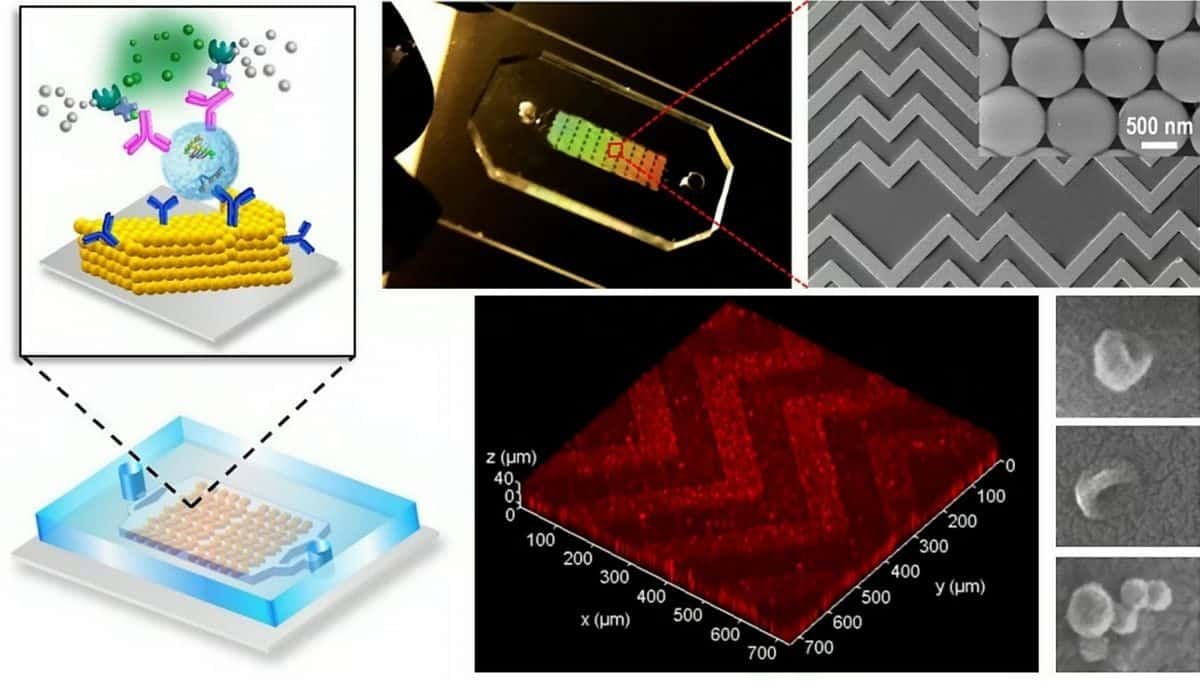A ‘lab-on-a-chip’ that can detect cancer early from a drop of blood has been unveiled by scientists.
The ultrasensitive device was hailed as “especially important” for ovarian and other cancers with poor early detection rates.
The chip has a nano-engineered surface that acts like thousands of tiny sinks to bring sensors closer to exosomes – signs of tumour growth – in the blood.
Researchers at the University of Kansas in the US said the “simple and low-cost” chip could detect dementia as well and had “great potential” to be used by clinicians.
Lead study author Associate Professor of Chemistry Yong Zeng at KU said its design was easy enough for a college student to replicate.
He said: “Historically, people thought exosomes were like ‘trash bags’ that cells could use to dump unwanted cellular contents.
“But in the past decade, scientists realised they were quite useful for sending messages to recipient cells and communicating molecular information important in many biological functions.
“Basically, tumours send out exosomes packaging active molecules that mirror the biological features of the parental cells. While all cells produce exosomes, tumour cells are really active compared to normal cells.”
The chip’s pioneering feature is found in its advanced nanoporous sensing surface inspired by a “herringbone” pattern found in nature.
This surface efficiently pushes exosomes into contact with it to allow “mass transfer” of molecules in the blood or plasma with the chip’s sensory area.
Dr Zeng said: “People have developed smart ideas to improve mass transfer in microscale channels, but when particles are moving closer to the sensor surface, they’re separated by a small gap of liquid that creates increasing hydrodynamic resistance.
“Here, we developed a 3D nanoporous herringbone structure that can drain the liquid in that gap to bring the particles in hard contact with the surface where probes can recognise and capture them.”
Dr Zeng compared the chip’s nanopores to a million little kitchen sinks.
He added: “If you have a sink filled with water and many balls floating on the surface, how do you get all the balls in contact with the bottom of the sink where sensors could analyse them? The easiest way is to drain the water.

“Now, we’re looking at cell-culture models, animal models, and also clinical patient samples, so we are truly doing some translational research to move the device from the lab setting to more clinical applications.
“Almost all mammalian cells release exosomes, so the application is not just limited to ovarian cancer or any one type of cancer. We’re working with people to look at neurodegenerative diseases, breast and colorectal cancers, for example.”
The new microfluidic chips are so simple that a schoolchildren could make them in a lab, he added.
Dr Zeng said: “What we created here is a 3D nanopatterning method without the need for any fancy nanofabrication equipment — an undergraduate or even a high school student can do it in my lab.
“This is so simple and low-cost it has great potential to translate into clinical settings.
“We’ve been collaborating with Dr Godwin and other research labs at The KU Cancer Centre and the molecular biosciences department to further explore the translational applications of the technology.”
He tested the device on ovarian cancer patients with collaborators Dr Andrew Godwin, a tumour-biomarker expert and KU Cancer Center and Deputy Director at the KU Medical Center’s Department of Pathology & Laboratory Medicine, and graduate student Ashley Tetlow in Godwin’s Biomarker Discovery Lab.
Dr Godwin said: “Our collaborative studies continue to bear fruit and advance an area crucial in cancer research and patient care — namely, innovative tools for early detection.
“This area of study is especially important for cancers such as ovarian, given the vast majority of women are diagnosed at an advanced stage when, sadly, the disease is for the most part incurable.”
The “lab-on-a-chip” for “liquid biopsy” analysis was published in Nature Biomedical Engineering.
By Berny Torre & Joe Mellor

